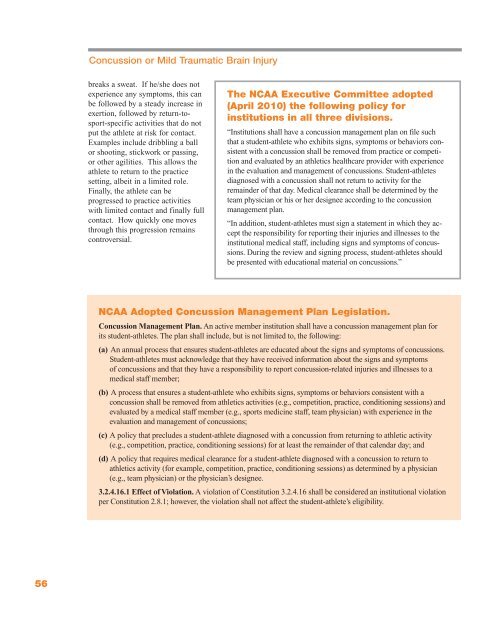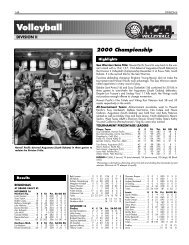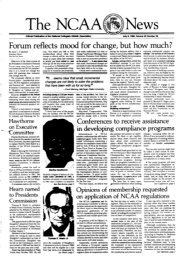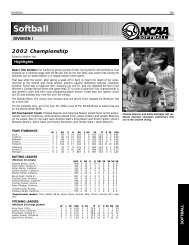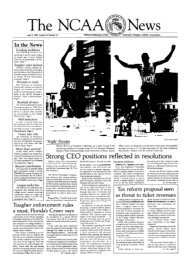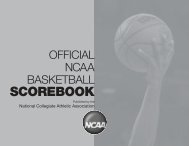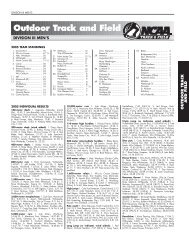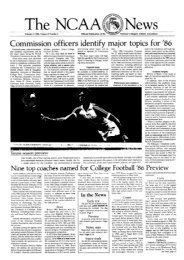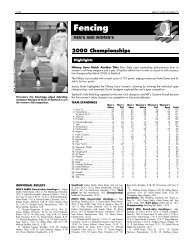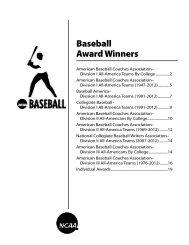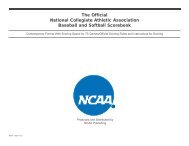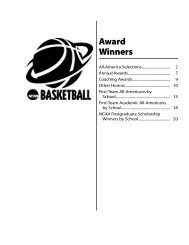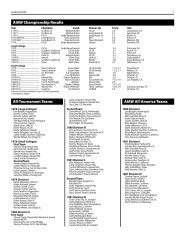Sports Medicine Handbook - NCAA
Sports Medicine Handbook - NCAA
Sports Medicine Handbook - NCAA
Create successful ePaper yourself
Turn your PDF publications into a flip-book with our unique Google optimized e-Paper software.
56<br />
Concussion or Mild Traumatic Brain Injury<br />
breaks a sweat. If he/she does not<br />
experience any symptoms, this can<br />
be followed by a steady increase in<br />
exertion, followed by return-tosport-specific<br />
activities that do not<br />
put the athlete at risk for contact.<br />
Examples include dribbling a ball<br />
or shooting, stickwork or passing,<br />
or other agilities. This allows the<br />
athlete to return to the practice<br />
setting, albeit in a limited role.<br />
Finally, the athlete can be<br />
progressed to practice activities<br />
with limited contact and finally full<br />
contact. How quickly one moves<br />
through this progression remains<br />
controversial.<br />
The <strong>NCAA</strong> Executive Committee adopted<br />
(April 2010) the following policy for<br />
institutions in all three divisions.<br />
“Institutions shall have a concussion management plan on file such<br />
that a student-athlete who exhibits signs, symptoms or behaviors consistent<br />
with a concussion shall be removed from practice or competition<br />
and evaluated by an athletics healthcare provider with experience<br />
in the evaluation and management of concussions. Student-athletes<br />
diagnosed with a concussion shall not return to activity for the<br />
remainder of that day. Medical clearance shall be determined by the<br />
team physician or his or her designee according to the concussion<br />
management plan.<br />
“In addition, student-athletes must sign a statement in which they accept<br />
the responsibility for reporting their injuries and illnesses to the<br />
institutional medical staff, including signs and symptoms of concussions.<br />
During the review and signing process, student-athletes should<br />
be presented with educational material on concussions.”<br />
<strong>NCAA</strong> Adopted Concussion Management Plan Legislation.<br />
Concussion Management Plan. An active member institution shall have a concussion management plan for<br />
its student-athletes. The plan shall include, but is not limited to, the following:<br />
(a) An annual process that ensures student-athletes are educated about the signs and symptoms of concussions.<br />
Student-athletes must acknowledge that they have received information about the signs and symptoms<br />
of concussions and that they have a responsibility to report concussion-related injuries and illnesses to a<br />
medical staff member;<br />
(b) A process that ensures a student-athlete who exhibits signs, symptoms or behaviors consistent with a<br />
concussion shall be removed from athletics activities (e.g., competition, practice, conditioning sessions) and<br />
evaluated by a medical staff member (e.g., sports medicine staff, team physician) with experience in the<br />
evaluation and management of concussions;<br />
(c) A policy that precludes a student-athlete diagnosed with a concussion from returning to athletic activity<br />
(e.g., competition, practice, conditioning sessions) for at least the remainder of that calendar day; and<br />
(d) A policy that requires medical clearance for a student-athlete diagnosed with a concussion to return to<br />
athletics activity (for example, competition, practice, conditioning sessions) as determined by a physician<br />
(e.g., team physician) or the physician’s designee.<br />
3.2.4.16.1 Effect of Violation. A violation of Constitution 3.2.4.16 shall be considered an institutional violation<br />
per Constitution 2.8.1; however, the violation shall not affect the student-athlete’s eligibility.


